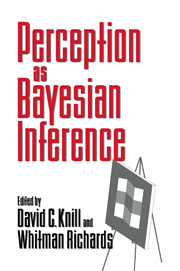Book contents
- Frontmatter
- Contents
- List of contributors
- Preface
- 0 Introduction
- Part one Bayesian frameworks
- 1 Pattern theory: A unifying perspective
- 2 Modal structure and reliable inference
- 3 Priors, preferences and categorical percepts
- 4 Bayesian decision theory and psychophysics
- 5 Observer theory, Bayes theory, and psychophysics
- Commentaries
- Part two Implications and applications
- Commentaries
- Author index
- Subject index
1 - Pattern theory: A unifying perspective
Published online by Cambridge University Press: 05 March 2012
- Frontmatter
- Contents
- List of contributors
- Preface
- 0 Introduction
- Part one Bayesian frameworks
- 1 Pattern theory: A unifying perspective
- 2 Modal structure and reliable inference
- 3 Priors, preferences and categorical percepts
- 4 Bayesian decision theory and psychophysics
- 5 Observer theory, Bayes theory, and psychophysics
- Commentaries
- Part two Implications and applications
- Commentaries
- Author index
- Subject index
Summary
Introduction
The term “Pattern Theory” was introduced by Ulf Grenander in the 70's as a name for a field of applied mathematics which gave a theoretical setting for a large number of related ideas, techniques and results from fields such as computer vision, speech recognition, image and acoustic signal processing, pattern recognition and its statistical side, neural nets and parts of artificial intelligence (see Grenander, 1976-81). When I first began to study computer vision about ten years ago, I read parts of this book but did not really understand his insight. However, as I worked in the field, every time I felt I saw what was going on in a broader perspective or saw some theme which seemed to pull together the field as a whole, it turned out that this theme was part of what Grenander called pattern theory. It seems to me now that this is the right framework for these areas, and, as these fields have been growing explosively, the time is ripe for making an attempt to reexamine recent progress and try to make the ideas behind this unification better known. This article presents pattern theory from my point of view, which may be somewhat narrower than Grenander's, updated with recent examples involving interesting new mathematics.
Information
- Type
- Chapter
- Information
- Perception as Bayesian Inference , pp. 25 - 62Publisher: Cambridge University PressPrint publication year: 1996
Accessibility standard: Unknown
Why this information is here
This section outlines the accessibility features of this content - including support for screen readers, full keyboard navigation and high-contrast display options. This may not be relevant for you.Accessibility Information
- 34
- Cited by
